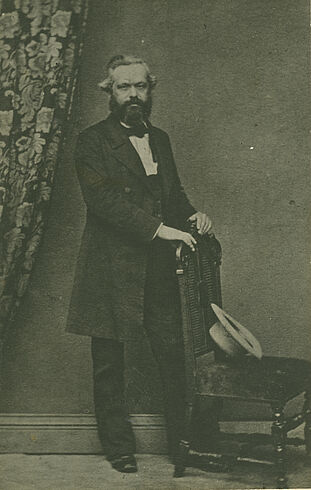Karl Marx and Capitalism
At the Deutsches Historisches Museum from 10 February 2022
Download
Since the global financial and economic crisis of 2008/2009 at the very latest, capitalism and its most important analyst and critic, Karl Marx, have once again been the objects of heavy attention. As the namesake of authoritarian ideologies and dictatorships in the 20th century, Marx remains controversial. At the same time, the questions he posed in his 19th-century critique of economy and society amid the shift from industrial to post-industrial society are more timely than ever. In the exhibition “Karl Marx and Capitalism” (10 February to 21 August 2022), the Deutsches Historisches Museum presents and critically examines Marx’ thought and influence as an intellectual and political confrontation with the profound crises and conflicts of his time.
Industrialization catalyzed enormous economical, social, and cultural upheavals across Germany and Europe in the 19th century, changes that were perceived as threats to the social fabric. Beyond a dual political and economic revolution, the first modern wave of globalization occurred at this time. Karl Marx was among the sharpest critics of the volatility of modernity and a dynamically changing capitalism. Philosopher, journalist, economist, and political activist, he aimed to make the new dynamics comprehensible and malleable. Marx understood capitalism as a globalized, principally crisis-oriented economic and social order that would be superseded by a communist society after a proletarian revolution. Being a revolutionary and stateless European of German origins, he was influenced by developments in France, Great Britain, the USA, India, and Russia; and conversely, his analysis would influence the reform and workers’ movements in various countries.
“Karl Marx and Capitalism” shows what motivated Marx, to what he was reacting, how his theories evolved, and where he contradicted himself. The exhibition centers on seven topics that defined the present Marx inhabited and his critique of capitalism – none of which have lost any explosiveness since: religious and social critique controversies, antisemitism, revolution and violence, new technologies, the destruction of nature, global economic crises, as well as international protest and emancipation movements.
The exhibition thus also connects the historicization of Marx to questions of his currency. At the same time, the epilogue section takes a critical look at the worldwide reception of his theories in the 20th and 21st centuries, making clear how Marx’ fundamentally ambivalent work also made a fundamentally ambivalent historical impact.
Aside from paintings, drawings, documents, photographs, and posters, curator Sabine Kritter draws on audio collages, graphics, and animations to juxtapose Marx’ analyses with his epoch. Original objects such as a steam engine and an eight-hour clock, as well as interactive stations and an olfactory art installation all displayed across ca. 500 square meters demonstrate the raw power and ambivalent nature of technological and social transformation in the 19th century. The fact that Marx’ contemporary diagnoses and future prognoses changed and remained in part contradictory is shown in the exhibition using archival materials including Marx’ handwritten notes in his personal copy of “Capital” (1867) and the “Communist Manifesto” written with his long-time companion Friedrich Engels in 1848 with a revised preface by the authors appended to the 1872 edition. An imposing marble bust of Marx, an official gift to the GDR by People’s Republic of Romania for “Karl Marx Year” in 1953 that was displayed in the first exhibition of the GDR’s recently founded Museum für Deutsche Geschichte (Museum for German History), is indicative of the ideological appropriation of Marx’ ideas in the 20th century.
Karl Marx and Richard Wagner: Two 19th Century Contemporaries
In 2022, the Deutsches Historisches Museum devotes itself to two German personalities of the 19th century: contemporaries Karl Marx (1818-83) and Richard Wagner (1813-83). Each made an enormous impact on the 19th and 20th centuries that endures into the 21st century. And both would be elevated to the status of icons, though by opposing political camps: Marx by the left, Wagner by the right. Save for a few years, they experienced the same world, observed the same economic and social upheavals, but ultimately drew very different conclusions: Marx wanted to overtake modernity; Wagner wanted to overhaul it.
Running parallel to “Karl Marx and Capitalism”, the exhibition “Richard Wagner and the Nationalization of Feeling” will be on view at the Deutsches Historisches Museum from 8 April to 11 September 2022. This latter shows Wagner not only as a witness to and critic of the political and social upheavals of the 19th century, but also as a controversial artist and entrepreneur adept at strategically incorporating societal and emotional sensitivities in his work and staging them as Deutschtum (Germanness) – a man whose success would have been unthinkable without a modern capitalist art market.
Press images in high resolution acan be downloaded after registering or loggin in.

Historic photography of Karl Marx
London, 1861 © International Institute of Social History, Amsterdam